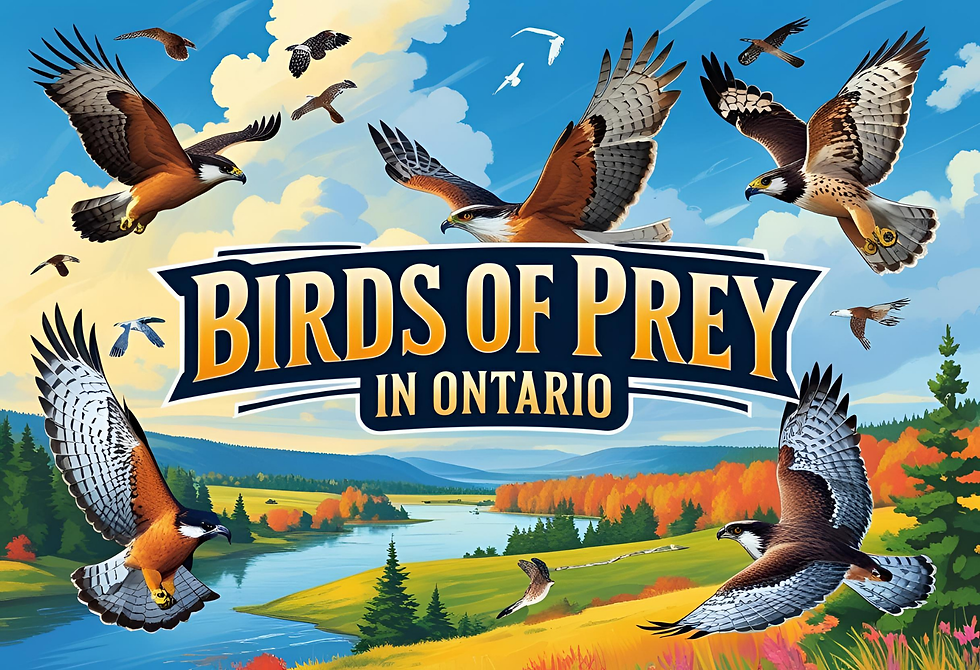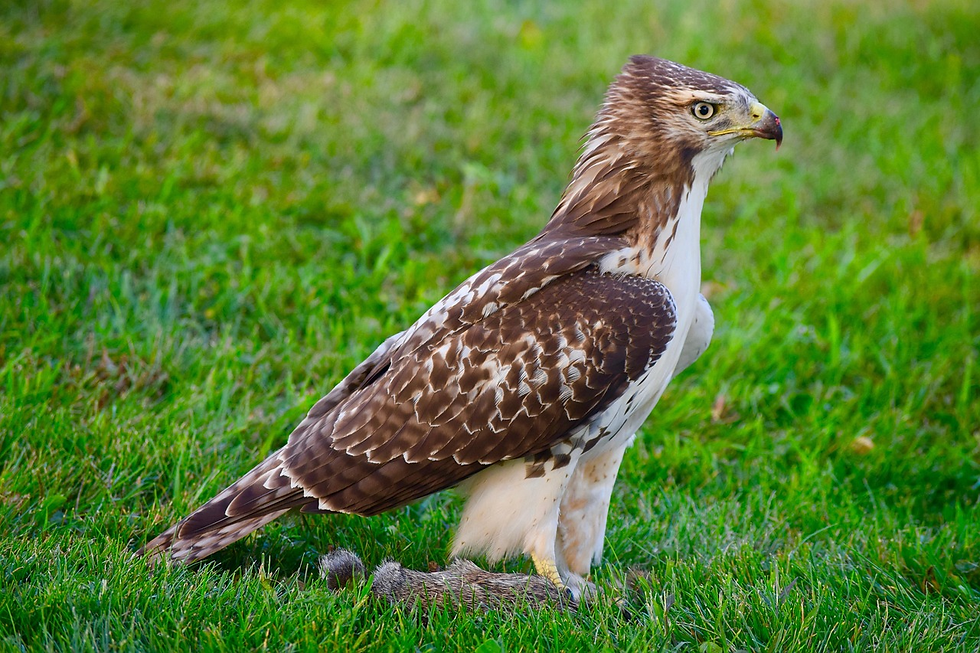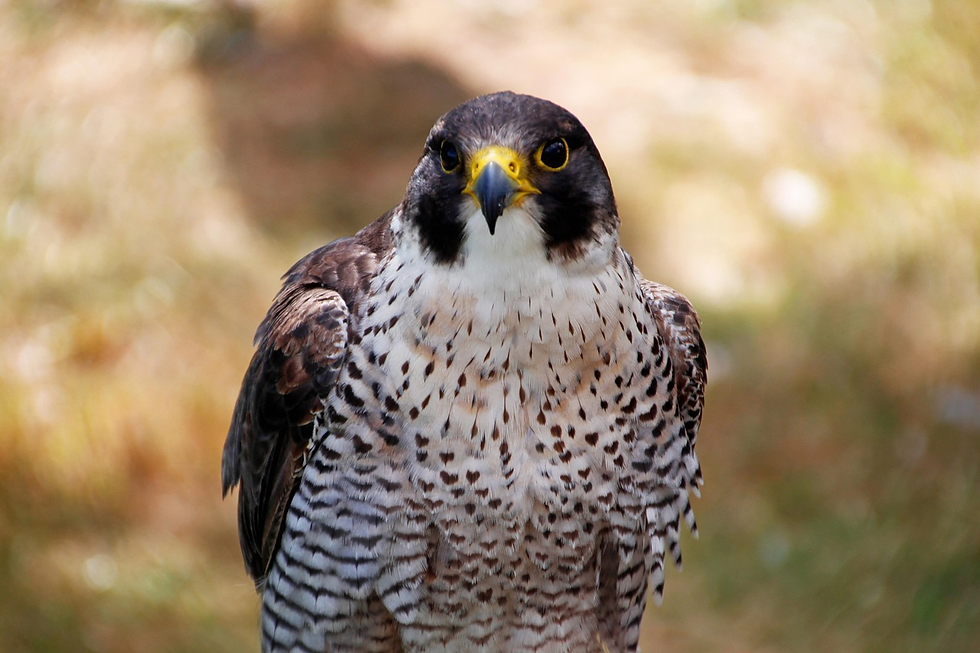A Complete Guide to Birds of Prey in Ontario
- Colton C
- Jun 23, 2025
- 8 min read
Updated: Oct 31, 2025
Ontario’s skies are home to a remarkable variety of birds of prey, or raptors — powerful hunters with razor-sharp talons, hooked beaks, and extraordinary senses. These birds are not just awe-inspiring to watch; they also play vital roles in local ecosystems by keeping populations of rodents and other small animals in check. From the thunderous dive of a peregrine falcon to the eerie nighttime call of a barred owl, Ontario’s raptors are as diverse in behavior as they are in appearance. Whether you're an experienced birder or just discovering the world of wildlife, understanding these aerial predators will deepen your appreciation of Ontario's natural heritage.
The province's vast landscapes, which include forests, wetlands, grasslands, and lakes, support over twenty species of birds of prey. While some are year-round residents, others migrate great distances to breed or overwinter in Ontario. These birds can be seen perched on telephone poles, gliding above fields, or nesting on cliff sides and urban buildings. In this guide, you’ll learn how to identify these species, where to spot them, and how they contribute to the environment.
Disclaimer: This article contains affiliate links. We may earn a small commission from any purchase made through these links at no additional cost to you.

What Are Birds of Prey?
Defining Raptors
Birds of prey are carnivorous birds that feed primarily on live prey. They are distinguished by their strong, curved beaks designed for tearing flesh and powerful talons for grasping and killing. Most raptors also have exceptional eyesight or hearing, allowing them to detect prey from incredible distances or even in complete darkness. Unlike scavengers, many raptors are active hunters, although some species, like vultures, rely on carrion.
You may be interested in Aurosports 10x25 Hiking Binoculars
These birds tend to be solitary, territorial, and highly specialized in their hunting methods. Raptors can be diurnal, like hawks and falcons, or nocturnal, like owls. The diversity in their anatomy and behavior enables different species to coexist in the same region without directly competing for food. This specialization is a key reason for their evolutionary success across the globe, including in Ontario.
Types of Raptors in Ontario
Ontario hosts six main types of birds of prey:
Hawks
Eagles
Falcons
Owls
Vultures
Ospreys
Each group includes species with unique traits and habits, making Ontario an exciting place for birdwatchers and nature lovers alike.
Hawks of Ontario

Red-tailed Hawk
The Red-tailed Hawk is one of the most widespread and recognizable birds of prey in Ontario. It is known for its broad wings, short tail, and striking reddish hue on its tail feathers. These hawks prefer open habitats such as meadows, pastures, and roadsides where they can perch on utility poles or tree branches to scout for prey. Their diet consists mainly of rodents, but they will also eat birds, reptiles, and even insects.
Behavior and Habitat
Red-tailed Hawks are often seen soaring in wide circles high above fields or perched in silent vigilance. They are territorial and monogamous, usually nesting in tall trees or on cliffs. Their call — a raspy scream — is frequently used in movies as a stand-in for other birds of prey. Despite being a common sight, they are vital to controlling pest populations.
Cooper’s Hawk and Sharp-shinned Hawk
These two hawks are often confused due to their similar size and appearance. Both are agile forest hunters with long tails and short, rounded wings, making them adept at flying through dense woodland. Cooper’s Hawks are larger and more robust, while Sharp-shinned Hawks are smaller with proportionally thinner legs and feet.
Hunting Behavior
These hawks specialize in hunting small birds, often ambushing them at backyard feeders. Their flight style is fast and maneuverable, involving short bursts followed by glides. They are known for their fierce determination and will chase prey through branches and shrubs. During migration, they can be seen in larger numbers along forested ridges and lakeshores.
Falcons of Ontario

Peregrine Falcon
Known as the fastest animal on Earth, the Peregrine Falcon is a spectacular sight in the Ontario skies. This sleek bird can reach speeds over 300 km/h when diving for prey. Originally nesting on cliffs, many have adapted to urban life by nesting on tall buildings and bridges. Thanks to conservation efforts, their population has rebounded after severe declines due to DDT exposure in the mid-20th century.
Urban Adaptation and Comeback
Peregrine Falcons have shown remarkable resilience in urban settings where pigeons, their primary prey, are plentiful. Nesting programs in cities like Toronto and Ottawa have helped support their recovery. Banding and monitoring have allowed researchers to track their migration and reproductive success. They remain a conservation success story in Ontario.
American Kestrel
The American Kestrel is Ontario’s smallest falcon, known for its colorful plumage and energetic hunting style. Males have blue-gray wings while females are more rust-colored overall. These falcons prefer open fields, farmlands, and roadways, often seen hovering in place while scanning the ground for insects and small rodents.
Nesting and Behavior
They nest in cavities such as old woodpecker holes, barn eaves, and specially placed nest boxes. Kestrels are monogamous during the breeding season and may reuse successful nesting sites. Their presence is often an indicator of healthy, open habitats with plenty of prey. Despite their size, they are aggressive hunters and will even chase off larger birds.
Owls of Ontario

Great Horned Owl
The Great Horned Owl is one of Ontario’s most formidable nocturnal predators. With its tufted “horns” and deep hoots, this owl is widespread and easily recognized. It has a varied diet, feeding on mammals, birds, reptiles, and even skunks, thanks to its weak sense of smell. This adaptability has made it one of the most successful owl species in North America.
You may be interested in Birdwatching Log Book
Hunting Strategy
Great Horned Owls rely on stealth, using their soft-edged feathers to fly silently through forests. Their strong talons exert enough force to sever the spine of their prey instantly. Nesting in tree hollows or old hawk nests, they fiercely defend their young. They are most often heard at night, and spotting one requires patience and a sharp ear.
Barred Owl
Known for its haunting “Who cooks for you?” call, the Barred Owl is another widespread species in Ontario. It prefers mature mixed forests near water and is most active at dusk and dawn. Unlike many owls, Barred Owls may be seen hunting during daylight, especially on overcast days.
Territorial Nature
Barred Owls are highly territorial and monogamous. They use the same nest for many years, usually a natural cavity or an abandoned platform built by other birds. Their diet is diverse and includes small mammals, amphibians, and invertebrates. They are relatively tolerant of human presence and can even be seen in suburban woodlands.
Eagles of Ontario

Bald Eagle
The Bald Eagle, once endangered in Ontario, has made a dramatic comeback. This majestic bird is known for its white head and tail, dark brown body, and massive wingspan that can reach over 2 meters. Found near large bodies of water, Bald Eagles feed primarily on fish but will also scavenge carrion.
Comeback and Conservation
Their return is a result of habitat protection, pesticide regulation, and nest monitoring. Today, Bald Eagles nest in remote areas of Northern Ontario, the Great Lakes shores, and some southern rivers. They build enormous nests, sometimes reused and added to for decades. Sightings are increasingly common during winter, especially near open water.
Golden Eagle
Golden Eagles are rare in Ontario but may be spotted during migration. These powerful raptors are more common in western Canada but occasionally travel through the province. They favor open landscapes such as tundra, meadows, and rocky cliffs.
Identifying Features
They are uniformly dark brown with golden feathers on the back of the head and neck. Unlike Bald Eagles, they hunt more actively, preying on rabbits, ground squirrels, and birds. Their presence in Ontario is seasonal and usually limited to migration corridors and northern regions.
Ospreys and Vultures

Osprey
The Osprey is a fish-eating raptor found near Ontario’s rivers, lakes, and reservoirs. It has a white underside, dark back, and a distinctive dark eye stripe. Unlike other raptors, the Osprey has reversible outer toes and barbed footpads to help grip slippery fish.
Nesting and Diet
Ospreys build large nests on man-made platforms, utility poles, and dead trees near water. They plunge into water feet-first to catch fish, often emerging with a wriggling meal. Their population has grown thanks to nest protection efforts and better water quality. They are common sights near cottage lakes and rivers throughout southern and central Ontario.
Turkey Vulture
While not hunters, Turkey Vultures are essential scavengers in Ontario’s ecosystems. These large, dark birds are often seen soaring in circles with their wings held in a slight V-shape. They have red, featherless heads and excellent senses of smell, which they use to locate decaying animals.
You may be interested in Birdwatching Log Book
Ecological Role
Vultures play a key role by cleaning up carrion and preventing the spread of disease. They do not harm live animals and are entirely non-aggressive. Though their appearance is grim, their presence is vital to a healthy ecosystem. They are most common during warmer months and migrate south in the fall.
Comparison Table: Raptors in Ontario
Species | Size | Preferred Habitat | Primary Diet | Season in Ontario |
Red-tailed Hawk | Medium-Large | Fields, forests, roadsides | Rodents, birds, reptiles | Year-round |
Peregrine Falcon | Medium | Cliffs, cities | Birds (pigeons, etc.) | Spring to Fall |
Great Horned Owl | Large | Forests, mixed woodlands | Mammals, birds | Year-round |
Bald Eagle | Very Large | Lakes, rivers | Fish, carrion | Mostly Year-round |
Osprey | Medium-Large | Lakes, rivers | Fish | Spring to Fall |
Turkey Vulture | Large | Open country, forests | Carrion | Spring to Fall |
Best Places to See Raptors in Ontario

Raptor Hotspots
Ontario is filled with prime raptor-watching locations. Whether you're hoping to see a Bald Eagle fishing in Georgian Bay or a hawk migration along the escarpment, there’s no shortage of opportunities.
Some top places include:
Hawk Cliff, Port Stanley – Famous for fall hawk migrations.
Algonquin Provincial Park – Great for owls, hawks, and eagles.
Presqu’ile Provincial Park – Known for spring and fall migrations.
Niagara Peninsula – Offers year-round views of turkey vultures and peregrine falcons.
Tips for Birdwatching
Use binoculars or a spotting scope for clearer views.
Visit during early morning or dusk when raptors are most active.
Stay quiet and move slowly to avoid scaring birds away.
Research seasonal migrations for best viewing times.
Conservation and Threats
Human Impacts
Despite many success stories, raptors still face threats in Ontario. Habitat loss, pesticide use, and collisions with vehicles or buildings remain serious concerns. Illegal hunting and nest disturbance also pose risks, especially for rare species.
How You Can Help
Supporting raptor conservation can be as simple as:
Installing nest boxes for owls and kestrels.
Reporting illegal activity like nest disturbances.
Supporting organizations like the Canadian Raptor Conservancy or Birds Canada.
Advocating for green spaces and protected natural areas.
Final Thoughts

Birds of prey are among the most captivating and ecologically important animals in Ontario. Their beauty, strength, and role in the food chain make them essential to the province’s biodiversity. From the piercing cry of a Red-tailed Hawk to the silent glide of an owl, each encounter with a raptor is a moment of awe. As we learn more about these magnificent creatures, we also gain a deeper connection to the natural world.
Whether you’re scanning treetops while hiking or watching from your backyard, knowing how to identify and appreciate these birds enriches your outdoor experience. With continued conservation and public interest, Ontario’s skies will remain full of raptors for generations to come.




Comments